BALANCING "NATIVE" AND "FOREIGN" ELEMENTS IN ANCIENT JAPAN
Even with Japan’s geographical isolation, a significant amount of beliefs, ideas, and culture from China and Korea have become crucial components of Japanese civilization. However, as noted by Varley on page 57, “[Japan] did not slavishly copy Chinese [and Korean] civilization; some important institutions... were considerably remodeled.” The Japanese have selectively reshaped cultural borrowings to produce uniquely native traditions, as shown by the integration of written language, religion, and bureaucratic institutions from the Asian mainland.
When Korean scholars introduced the Chinese writing system to the Japanese at the beginning of the fifth century, Japanese civilization evolved in a variety of ways. Even with the structural differences between Chinese and Japanese, written Chinese had become an established form of official communication by the time a permanent capital was built at Nara in 710 (Varley 36). The imperial court’s dependence on written Chinese influenced early Japanese works, such as the national anthologies written entirely in Chinese, including the Nihon Shoki and the Kaifūsō. However, even in its nascent form, Japanese literature was influenced by native ideas and form. For example, the Man'yōshū, a collection of long poems, contains “a kind of native freshness (Varley 43).” While several entries address continental topics such as Confucianism, Man'yōshū does so against a backdrop of ancient Japanese virtues, such as makoto.
With the invention of kana, a native syllabary derived from Chinese characters, Japanese classical literature blossomed, deviating significantly from the Chinese model under the Heian court. Kana facilitated the growth of native prose literature which was given form in the nikki and monogatari. In Japan, female writers, utilizing kana generally due to being denied a formal education in written Chinese, were responsible for some of the period’s finest works, including The Tale of Genji. The increased use of written Japanese contributed to the growth of waka poetry as well, necessitating the use of complex meanings to overcome the limited sound variation of the Japanese language. Building upon the Japanese reverence for nature’s characteristic fragility, Japanese poetry integrated the flowery language of Chinese poetry into the strict form of the waka, which would remain unchanged for centuries.
The main religious import from the Asian continent was Buddhism, officially introduced from the Korean kingdom of Paekche around 552 (Varley 20). The Japanese ruling class played a key role in the early spread of Buddhism, evidenced by Emperor Shomu’s public endorsement of Buddhism during the Nara period. Official support for Buddhism from the imperial court at Nara shaped many of the unique Japanese sects which would develop in the following generations. Early on, Buddhism was mainly the domain of priests hired to ensure the prosperity of the imperial court. However, the development of an aristocratic class increased the popularity of newly formed esoteric sects, such as Shingon and Tendai during the late Nara period, and eventually Amidism which preached the universality of salvation.
Instead of facilitating a wholesale replacement of Shinto, Buddhism in its various forms fused with Shinto beliefs. “The doctrines of the two religions complement each other so neatly,” according to Varley on page 22. For example, many Japanese regarded Buddhism as a “potent form of magic for... warding off calamities (Varley 21),” and the kami could be regarded as manifestations of Buddhist deities. The capacity for this synthesis of Buddhism and Shinto to be reshaped in various social circumstances, evidenced above, helps explains its persistence as a formidable force in Japanese society and how the Japanese developed unique native sects.
After a period of disruption, Chinese rule was stabilized under the Sui and later T’ang dynasties, allowing for the continuation of missions between Japan and China. These missions provided Japan with the knowledge necessary to pursue a centralized bureaucracy on the model of China. For example, Prince Shotoku, a Confucian scholar and member of the Soga clan, propagated Chinese dynastic customs as a basis for legitimate rule in his Jūshichijō Kenpō. However, such customs were necessarily reconciled with the Shinto belief in a line of succession ordained by Amaterasu. Under future Soga rulers, a series of edicts patterned on the institutions of T’ang China were pursued in Japan to meticulous detail. For example, uncovered tax registers from the period are nearly identical in form to Chinese equivalents (Ryusaku 53).
Ironically, implementation of such reforms allowed Japanese bureaucratic institutions to develop in novel ways. For example, the Taika Reforms beginning in 645 were designed to curb the power of local clan leaders; in practice, aristocratic families accumulated large private estates and political power under the system. This led to a distinct court culture characterized by aristocratic jockeying for the reins of imperial power in the Heian period. Much removed from the Confucian ideals of government by merit, Japanese courtier society was highly hierarchical and featured a fixation on miyabi, or courtly refinement, as reflected primarily in uta nikki like The Pillow Book. While courtier society was supplanted by the warrior class, the new rulers “instinctively responded to and sought to perpetuate the courtly tradition (Varley 60).”
The evolution of Japanese civilization can be thought of as a continuous and selective reconciliation between “native” and “foreign” elements within Japanese society. From its most important imports from the Asian mainland, written Chinese, Buddhism, and a centralized bureaucracy, Japan has forged unique native traditions found nowhere else in the world. Even after coming into contact with the world at large, Japan has retained its ability to produce uniquely Japanese institutions amidst a variety of outside influences.




 8:18 PM
8:18 PM
 NoelVermillion
NoelVermillion










0 comments:
Post a Comment